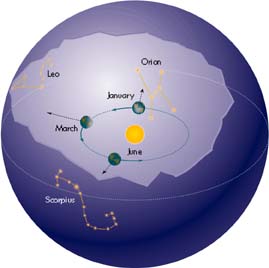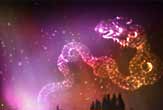 |
Seasonal Changes
- Why do constellations change?
At diferent times of the year, the Earth is at different points
along its orbit, and at night we face different directions.
- Examples: Scorpius in summer,
Leo in spring, Orion in winter.
Other Patterns
in the Sky
- Planetary alignments: The ancient
Chinese believed that a planet conjunction was an omen of change,
based on the fact that astronomers saw a five-planet conjunction,
in the constellation Dongjing (Gemini), one year after the Han
Dynasty came to power in 605 BC; but alignments really have no
effect on Earth or Earthlings.
Examples of
Constellations
- The Zodiac: From "zodiakos
kyklos", the circle of animals along the ecliptic [12, Ophiuchus
having been discarded]; To understand the origin of names, must
realize that the Earth's axis has precessed over 2000 years.
- Lyra: Apollo's harp.
- Orion: The hunter.
|
 Constellations and
Constellations and
 Constellations and
Constellations and

![]()